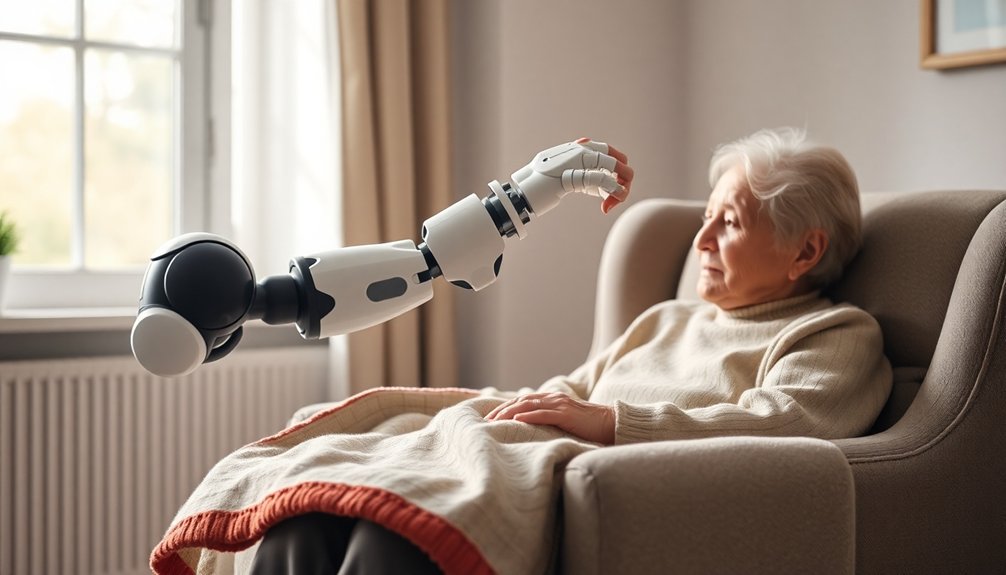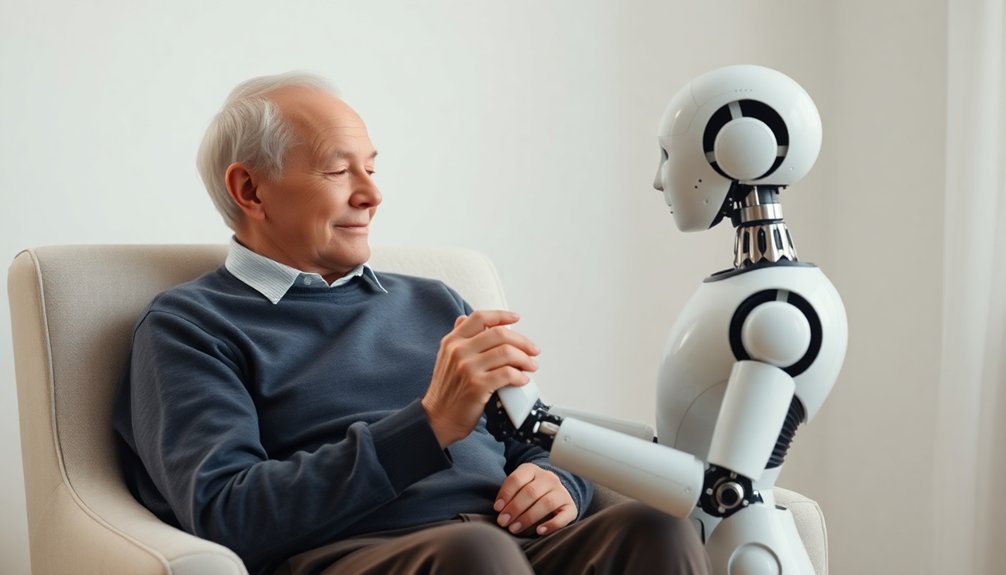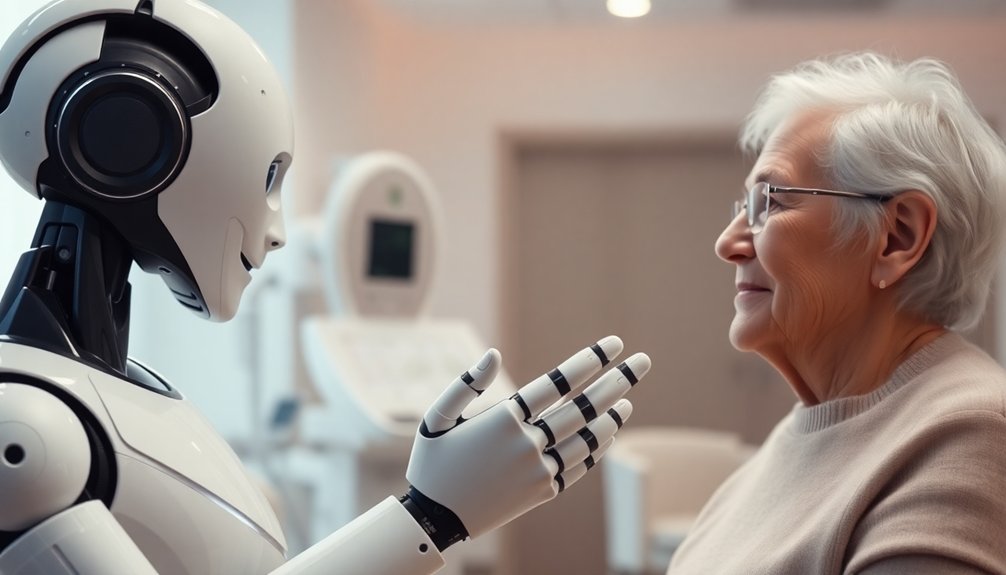Robot caregivers are like that well-intentioned friend who tries too hard—they’ll remember your meds and track your movements, but won’t truly understand your soul. You’ll get consistent support wrapped in cold algorithms, trading human warmth for technological efficiency. Privacy becomes a data point, emotional depth gets reduced to programmed responses. Are robots the future of elder care, or just fancy machines mimicking compassion? Stick around, and the rabbit hole gets deeper.
The Promise of Technological Caregiving

When you picture a robot caregiver, you might imagine a cold, metallic assistant straight out of a sci-fi movie. But these assistive robots are changing the game in care homes worldwide. Humanoid robots like Pepper are enhancing hospital and elder care experiences through personalized assistance and emotional support.
Imagine a companion that doesn’t get tired, doesn’t complain, and can help older adults maintain their mental health and independence. Care providers are discovering that these technological marvels can dramatically improve quality of care, offering consistent support where human limitations exist.
A robotic helper: tireless, patient, elevating elder care beyond human constraints.
From medication reminders to physical activity engagement, robots are stepping up where traditional care falls short. They’re not replacing human touch, but complementing it—bridging gaps in elder care with precision and reliability.
The ethical questions are complex, but the potential is undeniable. Who wouldn’t want a tireless, patient helper watching out for their loved ones?
Emotional Intelligence vs. Mechanical Interaction
You might think robots are the ultimate empathetic companions, but let’s be real: an algorithm can’t hold a candle to genuine human connection.
When your robotic buddy responds with pre-programmed sympathy, you’ll quickly realize that emotional intelligence isn’t something you can code—it’s a uniquely human dance of nuance, intuition, and raw feeling.
The intimacy gap between human and machine grows wider with each scripted response, leaving you wondering whether these mechanical caregivers are solving loneliness or just creating a more sophisticated form of isolation.
Empathy Gap Widening
As robotic companions inch closer to our daily lives, the emotional chasm between mechanical interaction and genuine human empathy grows wider and more concerning.
- Robot caregivers can’t truly understand complex emotional landscapes
- Ethical concerns about emotional neglect are mounting rapidly
- Human connection remains irreplaceable in caregiving roles
- Loneliness persists despite programmed companion interactions
You’re witnessing the stark reality of an expanding empathy gap. While these mechanical helpers might manage physical tasks, they’re emotionally tone-deaf.
They can’t read subtle emotional cues or provide the nuanced understanding human caregivers naturally offer.
Think about it: can an algorithm really comfort someone experiencing deep grief or anxiety?
These robot companions might seem interactive, but they’re ultimately sophisticated machines mimicking emotional support without genuine empathy.
The result? Elderly individuals risk feeling more isolated, their emotional needs unmet by cold, calculated responses that fundamentally lack human warmth.
Tactile sensors simulate touch without genuine emotional understanding, further highlighting the mechanical nature of robotic interactions.
Intimacy Versus Algorithm
Companion robots promise emotional support, but they’re fundamentally sophisticated calculators trying to simulate human connection. You’ve got social robots designed to reduce caregiver burden, yet they can’t replace the nuanced warmth of human interaction. Bipedal robots are increasingly being developed to navigate human spaces, potentially expanding their caregiving capabilities.
Older adults might appreciate these mechanical helpers, but they’ll still feel that underlying loneliness—an algorithm can’t replicate genuine compassion.
Think about it: how comfortable would you be sharing your deepest feelings with a machine that’s fundamentally following pre-programmed emotional scripts?
Ethical issues abound when we start replacing human touch with cold, calculated responses. These robots might help with tasks, but intimacy? That’s a bridge too far—for now.
Privacy, Dignity, and Human Connection

While companion robots promise technological solutions to aging and isolation, they’re walking a razor-thin line between helpful innovation and potential emotional intrusion.
Consider the ethical landmines:
- Privacy becomes a blurry concept when robots monitor your every move.
- Dignity gets compromised as humans potentially feel reduced to data points.
- Loneliness might be temporarily masked, but emotional support quality suffers.
- Socioeconomic access creates inequitable care distribution.
Your human connection isn’t just about filling silence—it’s about authentic interaction.
These algorithmic companions might track your health and provide consistent care, but they can’t replicate genuine empathy. They’ll listen without judgment, yet lack the nuanced understanding that makes human relationships meaningful.
Neural network architectures reveal that despite advanced pattern recognition, robots fundamentally struggle to comprehend the emotional depth of human interactions.
The real question isn’t whether robots can care, but whether their care truly matters when measured against the irreplaceable warmth of human touch.
Economic Barriers and Social Inequity
How much would you pay to have a robotic buddy keep Grandma company? These companion robots sound cool, but they come with a hefty price tag that screams “rich people only.”
Economic barriers are creating a tech-driven care divide where wealth determines who gets high-quality robotic caregiving. By 2040, we’ll be short 355,000 paid caregivers, yet only affluent families might afford these mechanical helpers. Electromechanical actuators powering these robots represent advanced technologies that further amplify the economic disparities in caregiving solutions.
Social inequity isn’t just a buzzword—it’s a real problem when vulnerable populations can’t access cutting-edge care technology. Imagine your low-income neighbor struggling while the family down the street has a fancy robot attending to their elderly parent.
The affordability gap means some seniors get state-of-the-art robotic companionship, while others are left with traditional, potentially inadequate care options.
Designing Empathetic Robotic Companions

Should we really expect robots to cuddle our grandparents? User-centered design isn’t just tech magic—it’s about creating empathetic robots that don’t creep people out.
Here’s what makes a companion robot less “Black Mirror” and more “warm hug”:
- Soft fur that begs to be petted
- Eyes that spark emotional connections
- Movements mimicking familiar pets
- Interactive features that feel human-like
Designing for older adults means listening to their actual needs, not just throwing silicon and circuits at the problem.
Accessibility matters, which means wrestling with affordability without sacrificing quality. The goal isn’t to replace human connection, but to supplement care with something that feels genuinely comforting.
Tech should empower, not replace—companion robots must comfort without breaking the bank.
Ethical considerations are vital—we’re creating companions, not replacements. Our robots should enhance, not infantilize, the human experience of aging.
Navigating the Ethical Landscape of Care Automation
Though companion robots promise to revolutionize eldercare, they’re walking a razor-thin line between innovation and invasion.
You’ve got to wonder: are these shiny metal caregivers solving problems or creating new ethical landmines? Privacy becomes a critical concern when robots enter intimate care settings, potentially stripping older adults of their dignity faster than you can say “automation.”
Access issues compound the problem—only wealthy families can afford these high-tech helpers, leaving lower-income seniors in the dust.
While companion robots might combat loneliness, they risk reducing genuine human contact to a programmed interaction.
Empirical research is desperately needed to understand the deeper ethical implications. Can a machine truly provide compassionate care, or are we just creating sophisticated sympathy simulators that feel more like clever toys than meaningful companions?
People Also Ask About Robots
What Are the Benefits of Companion Robots?
You’ll find companion robots reduce loneliness, lower depression, provide emotional support, and help caregivers manage daily tasks more effectively, especially for older adults and those with cognitive challenges like dementia.
Are Robot Companions Good for the Elderly?
Could companion robots truly support your aging journey? They’ve shown promise in reducing depression and agitation, offering comfort and interaction. However, they can’t fully replace human connection, so they’re best viewed as supplemental support, not complete caregiving solutions.
What Are the 2 Ethical Dilemmas Faced by Robotics?
You’ll grapple with two key ethical dilemmas: the potential loss of human compassion through robotic care and the privacy concerns surrounding constant monitoring of vulnerable individuals’ personal activities and health data.
Why Is There a Need for Robots That Can Help Care for People?
You’re drowning in a tsunami of aging populations! You’ll desperately need robots to fill massive caregiver shortages, provide consistent support, and help seniors maintain independence when human workers can’t meet overwhelming eldercare demands.
Why This Matters in Robotics
As robotic caregivers inch closer to reality, you’re standing at a crossroads of innovation and humanity. By 2030, experts predict 14% of eldercare could be robot-assisted—imagine that! You’ll need to wrestle with complex questions: Can algorithms truly replace human warmth? Will these mechanical helpers liberate or isolate us? The future isn’t about choosing between technology and compassion, but finding a delicate balance that honors both human dignity and technological potential.
